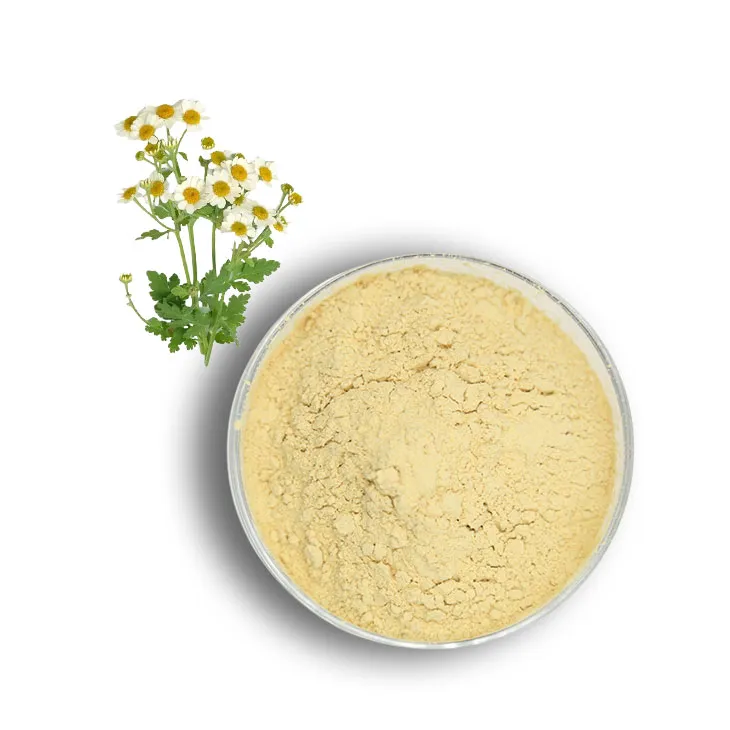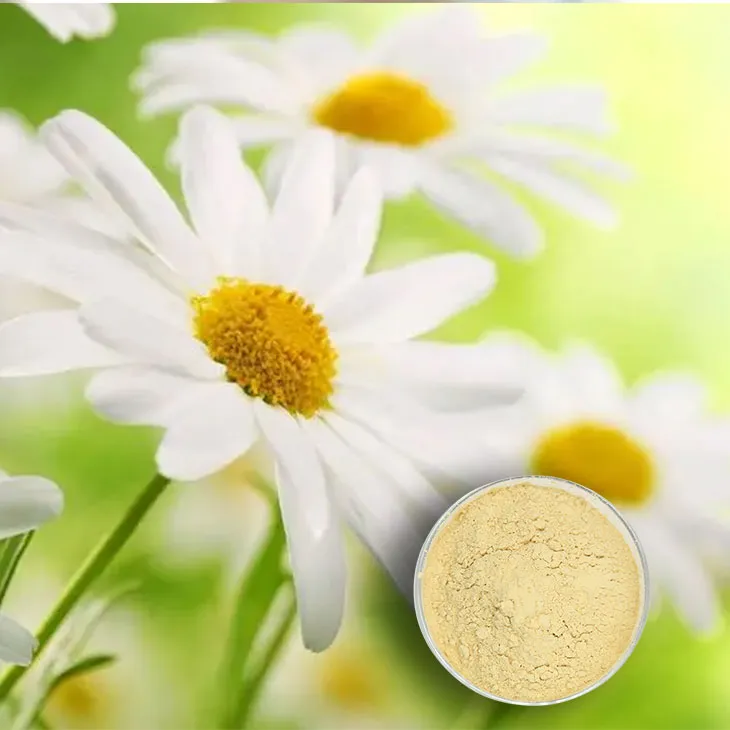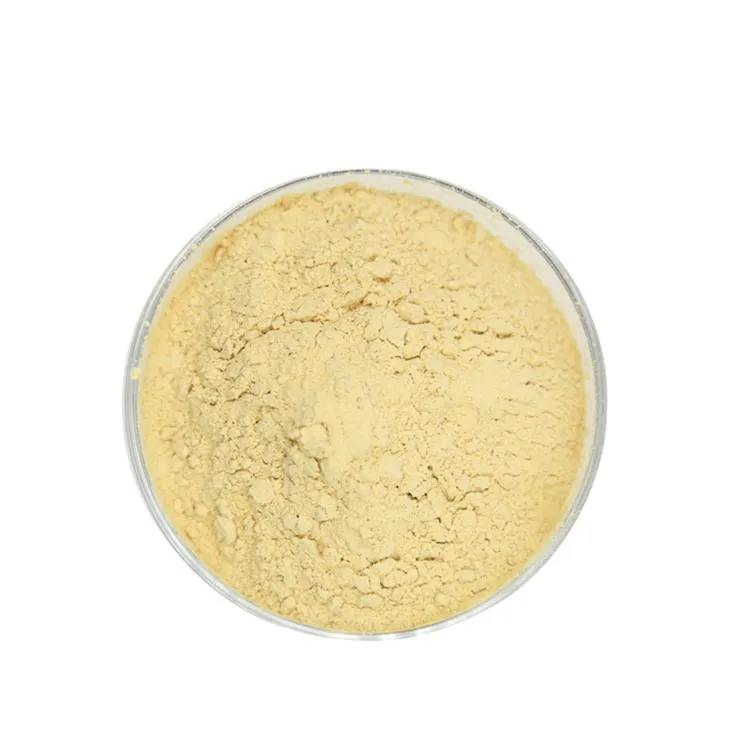- 0086-571-85302990
- sales@greenskybio.com
How to make powder from feverfew extract?
2024-11-28

1. Introduction to Feverfew Extract
Feverfew (Tanacetum parthenium), also known as white chamomile in some regions, has been used for centuries in traditional medicine. Its extract contains various bioactive compounds such as parthenolide, which is believed to have anti - inflammatory, anti - migraine, and antioxidant properties. The process of converting this valuable extract into a powder form can enhance its usability in different industries, including pharmaceuticals, cosmetics, and food supplements.

2. Gathering Fresh Feverfew
2.1 Selecting the Right Time
- The best time to gather fresh feverfew is during its flowering period. This is when the plant has the highest concentration of bioactive compounds. Usually, it flowers in the summer months, depending on the geographical location.
- It is important to avoid gathering the plant during wet or rainy days, as this can lead to mold growth and a decrease in the quality of the extract.
- Use clean and sharp gardening shears or scissors to cut the stems of the feverfew plants. Cut the stems close to the base, but be careful not to damage the root system if you want the plants to regrow in the same location.
- Only select healthy - looking plants, free from any signs of disease, pests, or physical damage. This ensures that the extract obtained will be of high quality.

3. Extraction Methods
3.1 Hydro - distillation
- Prepare the plant material: Wash the freshly harvested feverfew gently to remove any dirt or debris. Then, chop or grind the plant material into small pieces. This increases the surface area available for extraction.
- Set up the distillation apparatus: Place the chopped feverfew in a distillation flask. Add water to the flask, making sure the plant material is completely submerged. The ratio of plant material to water can vary, but a common ratio is 1:5 (1 part plant material to 5 parts water).
- Begin the distillation process: Heat the distillation flask gently. As the water heats up, it turns into steam, which carries the volatile compounds from the feverfew. The steam - laden with the extract - then travels through a condenser, where it cools and condenses back into a liquid.
- Collect the extract: The condensed liquid, which contains the Feverfew Extract, is collected in a separate container. This extract is a mixture of water and the bioactive compounds from the feverfew.
- Prepare the supercritical fluid: Carbon dioxide (CO₂) is commonly used as the supercritical fluid in this extraction method. It is pressurized and heated to reach its supercritical state, where it has properties of both a liquid and a gas.
- Place the feverfew in the extraction chamber: The fresh or dried feverfew is placed in the extraction chamber. The supercritical CO₂ is then passed through the chamber. The supercritical fluid can penetrate the plant cells and dissolve the bioactive compounds, such as parthenolide.
- Separate the extract: By adjusting the pressure and temperature, the supercritical CO₂ can be converted back to a gas, leaving behind the concentrated Feverfew Extract in the extraction chamber.
- Collect the extract: The pure feverfew extract is collected from the extraction chamber. This method is often preferred for its ability to produce a more pure and concentrated extract compared to hydro - distillation.

4. Centrifugation
After obtaining the feverfew extract, whether through hydro - distillation or supercritical fluid extraction, it may contain some remaining solids or impurities. Centrifugation is a crucial step to separate these substances.
- Transfer the extract to centrifuge tubes: Carefully pour the extract into centrifuge tubes. Make sure not to overfill the tubes to avoid spillage during the centrifugation process.
- Set the centrifuge parameters: The speed and time of centrifugation depend on the type and amount of extract. Generally, a speed of 3000 - 5000 revolutions per minute (rpm) for 10 - 20 minutes is sufficient to separate most of the solids.
- Perform the centrifugation: Place the centrifuge tubes in the centrifuge and start the process. As the centrifuge spins, the denser solids are forced to the bottom of the tubes, while the liquid extract remains on top.
- Separate the supernatant: After centrifugation, carefully remove the liquid extract (supernatant) from the top of the centrifuge tubes using a pipette or a decanting method. The separated supernatant is now closer to a pure feverfew extract and is ready for the next step of drying.

5. Drying into Powder
5.1 Low - Temperature Drying
- Spray Drying: This is a popular method for converting liquid extracts into powder. In spray drying, the feverfew extract is sprayed into a hot drying chamber in the form of fine droplets. The hot air in the chamber quickly evaporates the water from the droplets, leaving behind dry powder particles. However, to preserve the active ingredients, the temperature of the drying air should be carefully controlled. A temperature range of 40 - 60°C is often suitable for feverfew extract.
- Vacuum Drying: Another effective low - temperature drying method is vacuum drying. In this method, the feverfew extract is placed in a vacuum chamber. By reducing the pressure in the chamber, the boiling point of water is lowered. This allows the water in the extract to evaporate at a lower temperature, typically around 30 - 40°C. Vacuum drying is a gentle method that helps to preserve the delicate bioactive compounds in the feverfew extract.
- Once the dried feverfew extract has been obtained, it may be in the form of small flakes or chunks. These need to be ground into a fine powder. A mortar and pestle can be used for small - scale grinding, or a mechanical grinder can be employed for larger quantities.
- After grinding, the powder may still contain some larger particles or aggregates. Sieving through a fine - mesh sieve (e.g., a 100 - mesh sieve) can help to obtain a more uniform powder with a consistent particle size.

6. Applications of Feverfew Extract Powder
6.1 In Natural Skincare Products
- Anti - Inflammatory Properties: The parthenolide in feverfew extract powder can help reduce inflammation in the skin. It can be used in creams, lotions, and serums for treating skin conditions such as acne, eczema, and psoriasis.
- Antioxidant Effects: The powder can act as an antioxidant, protecting the skin from free - radical damage. This can help in reducing the signs of aging, such as wrinkles and fine lines.
- Headache and Migraine Relief: Feverfew has a long history of use for treating headaches and migraines. The powdered extract can be encapsulated or made into tablets for convenient consumption as a natural remedy.
- Anti - Inflammatory and Analgesic: In traditional medicine systems, feverfew is also used for its anti - inflammatory and analgesic properties. It can be used in herbal formulations for treating joint pain, muscle pain, and other inflammatory conditions.
- Supplements for Overall Health: Feverfew extract powder can be added to dietary supplements. It can provide the benefits of its bioactive compounds, such as parthenolide, for overall health improvement, including immune system support and antioxidant protection.
- Functional Foods: The powder can also be incorporated into functional foods, such as energy bars or health drinks. This allows consumers to obtain the health benefits of feverfew in a more convenient and palatable form.
7. Conclusion
The process of making powder from feverfew extract involves several important steps, from gathering fresh plants to the final drying and grinding. Each step requires careful attention to detail to ensure the quality and potency of the resulting powder. The powder has a wide range of applications in various industries, making it a valuable product. With the increasing demand for natural and plant - based products, the production of feverfew extract powder is likely to gain more importance in the future.
FAQ:
Question 1: What is the best way to extract white chamomile for making powder?
Hydro - distillation or supercritical fluid extraction are good methods for extracting white chamomile to make powder as they can provide better yield.
Question 2: Why is centrifuging necessary in the process of making white chamomile extract powder?
Centrifuging is necessary to separate any remaining solids in the white chamomile extract, which helps in obtaining a purer extract before turning it into powder.
Question 3: What are the advantages of using low - temperature drying methods to make white chamomile extract powder?
The advantage of using low - temperature drying methods to make white chamomile extract powder is that it can preserve the active ingredients in the extract.
Question 4: In which industries can white chamomile extract powder be used?
White chamomile extract powder can be used in natural skincare products, traditional medicine, and the nutraceutical industry.
Question 5: Are there any precautions to take during the extraction process for making white chamomile extract powder?
While the passage doesn't specifically mention precautions, in general, when using extraction methods like hydro - distillation or supercritical fluid extraction, one should ensure proper equipment operation, safety measures for handling chemicals (if any), and strict quality control to avoid contamination during the extraction process for making white chamomile extract powder.
Question 6: Can the extraction method affect the quality of white chamomile extract powder?
Yes, the extraction method can affect the quality of white chamomile extract powder. Different extraction methods may result in different yields and compositions of the extract, which in turn can influence the properties and quality of the final powder. For example, a better extraction method may lead to a higher concentration of active ingredients in the powder.
Related literature
- Advanced Extraction Techniques for Medicinal Plant Compounds"
- "White Chamomile: Properties and Applications in the Pharmaceutical and Cosmetic Industries"
- "Preservation of Active Ingredients in Herbal Extract Powders"
- ▶ Hesperidin
- ▶ citrus bioflavonoids
- ▶ plant extract
- ▶ lycopene
- ▶ Diosmin
- ▶ Grape seed extract
- ▶ Sea buckthorn Juice Powder
- ▶ Beetroot powder
- ▶ Hops Extract
- ▶ Artichoke Extract
- ▶ Reishi mushroom extract
- ▶ Astaxanthin
- ▶ Green Tea Extract
- ▶ Curcumin Extract
- ▶ Horse Chestnut Extract
- ▶ Other Problems
- ▶ Boswellia Serrata Extract
- ▶ Resveratrol Extract
- ▶ Marigold Extract
- ▶ Grape Leaf Extract
- ▶ blog3
- ▶ blog4
-
Bulk purchase of black pepper extract.
2024-11-28
-
Ginger extract of the best quality.
2024-11-28
-
Wholesale Passion Fruit Extract Suppliers.
2024-11-28
-
Organic Genistein, Australia.
2024-11-28
-
Acerola Extract
2024-11-28
-
Passionflower Extract
2024-11-28
-
Black Garlic Extract
2024-11-28
-
Quercetin
2024-11-28
-
Peppermint Extract Powder
2024-11-28
-
Oat Straw Extract Powder
2024-11-28
-
Rose Hip Extract
2024-11-28
-
Propolis Extract Powder
2024-11-28
-
Resveratrol extract
2024-11-28
-
Red Wine Extract
2024-11-28





















